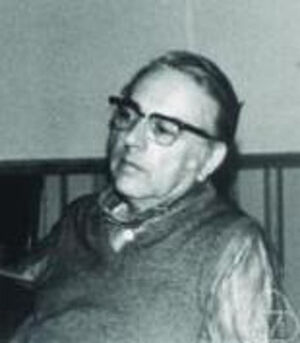Nathan Jacobson (nonfiction): Difference between revisions
No edit summary |
No edit summary |
||
| Line 7: | Line 7: | ||
At Princeton University, while working on his thesis, ''Non-commutative polynomials and cyclic algebras'', he was advised by [[Joseph Wedderburn (nonfiction)|Joseph Wedderburn]]. Jacobson was awarded a doctorate in mathematics from Princeton University in 1934. The theory of algebras in all its richness, a major area of twentieth-century mathematics, captivated Jacobson for the remainder of his career. | At Princeton University, while working on his thesis, ''Non-commutative polynomials and cyclic algebras'', he was advised by [[Joseph Wedderburn (nonfiction)|Joseph Wedderburn]]. Jacobson was awarded a doctorate in mathematics from Princeton University in 1934. The theory of algebras in all its richness, a major area of twentieth-century mathematics, captivated Jacobson for the remainder of his career. | ||
Jacobson next spent a year at the newly formed Institute for Advanced Study in Princeton, where he wrote up the first part of [[Hermann Weyl (nonfiction)|Hermann Weyl]]'s influential lectures on Lie groups and where he was first exposed to Lie algebras, the theory of which he developed himself from 1935 onward through the shrewd introduction of the techniques of modern abstract algebra. When [[Emmy Noether (nonfiction)Emmy Noether]]'s unexpected death in 1935 created a vacancy at Bryn Mawr, Jacobson accepted a yearlong lectureship there before taking a National Research Council fellowship to the University of Chicago in 1936-1937 to work with [[Abraham Adrian Albert (nonfiction)|Abraham Adrian Albert]]. | Jacobson next spent a year at the newly formed Institute for Advanced Study in Princeton, where he wrote up the first part of [[Hermann Weyl (nonfiction)|Hermann Weyl]]'s influential lectures on Lie groups and where he was first exposed to Lie algebras, the theory of which he developed himself from 1935 onward through the shrewd introduction of the techniques of modern abstract algebra. When [[Emmy Noether (nonfiction)|Emmy Noether]]'s unexpected death in 1935 created a vacancy at Bryn Mawr, Jacobson accepted a yearlong lectureship there before taking a National Research Council fellowship to the University of Chicago in 1936-1937 to work with [[Abraham Adrian Albert (nonfiction)|Abraham Adrian Albert]]. | ||
Although prospects were not bright for Jews in academia in the economically depressed 1930s, Jacobson was offered an instructorship at the University of North Carolina in 1938. | Although prospects were not bright for Jews in academia in the economically depressed 1930s, Jacobson was offered an instructorship at the University of North Carolina in 1938. | ||
Revision as of 13:04, 17 November 2017
Nathan Jacobson (October 5, 1910 – December 5, 1999) was an American mathematician.
Born Nachman Arbiser in Warsaw, Jacobson emigrated to America with his family in 1918.
He graduated from the University of Alabama in 1930.
At Princeton University, while working on his thesis, Non-commutative polynomials and cyclic algebras, he was advised by Joseph Wedderburn. Jacobson was awarded a doctorate in mathematics from Princeton University in 1934. The theory of algebras in all its richness, a major area of twentieth-century mathematics, captivated Jacobson for the remainder of his career.
Jacobson next spent a year at the newly formed Institute for Advanced Study in Princeton, where he wrote up the first part of Hermann Weyl's influential lectures on Lie groups and where he was first exposed to Lie algebras, the theory of which he developed himself from 1935 onward through the shrewd introduction of the techniques of modern abstract algebra. When Emmy Noether's unexpected death in 1935 created a vacancy at Bryn Mawr, Jacobson accepted a yearlong lectureship there before taking a National Research Council fellowship to the University of Chicago in 1936-1937 to work with Abraham Adrian Albert.
Although prospects were not bright for Jews in academia in the economically depressed 1930s, Jacobson was offered an instructorship at the University of North Carolina in 1938.
In 1943 the Jacobsons left North Carolina for Maryland, where Jacobson held an associate professorship at the Johns Hopkins University and taught in the U.S. Army training program. Over the next four years, he supervised thirty-three doctoral students, and launched a research agenda on the structure theory of rings without finiteness conditions--a subject closely related to the theory of algebras--that transformed the approach to classical results and broke ground for solutions to problems inaccessible by previous methods.
He joined Yale University in 1947, where he explored the structure theory of Jordan algebras, algebraic constructs developed in the 1930s in an effort to interpret quantum mechanics more effectively. He pursued this line of research for the rest of his career, publishing dozens of influential papers as well as three seminal textbooks on it, remaining at Yale until his retirement.
Recognized as one of the leading algebraists of his generation, he wrote more than a dozen standard textbooks.
He was a member of the National Academy of Sciences and the American Academy of Arts and Sciences. He served as president of the American Mathematical Society from 1971 to 1973, and was awarded their highest honour, the Leroy P. Steele prize for lifetime achievement, in 1998.
He was also vice-president of the International Mathematical Union from 1972 to 1974.
In the News
Fiction cross-reference
Nonfiction cross-reference
- Abraham Adrian Albert (nonfiction)
- Emmy Noether (nonfiction)
- Hermann Weyl (nonfiction)
- Joseph Wedderburn (nonfiction)
- Mathematician (nonfiction)
External links:
- Nathan Jacobson @ Wikipedia
- Jacobson, Nathan
